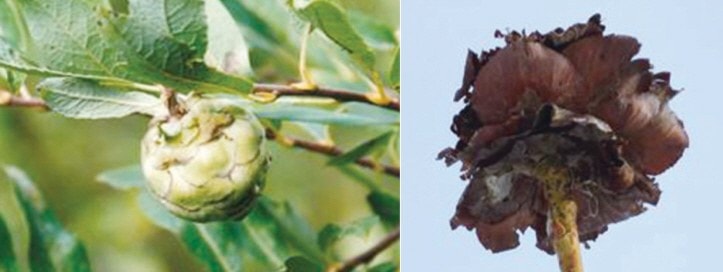Submitted by Charles Bird
At this time of year (mid-February), around Erskine in south-central Alberta, things look dreary outside. We have around 15 cm (6 inches) of snow on the ground, the migrating birds aren't back and the buds on the trees haven't started to swell. Nevertheless, we do have the winter birds and one can find tracks of coyotes, weasels and voles, and on trees we can find a wide variety of lichen species. When I was hiking down at Erskine Lake recently, I noticed a number of small, cauliflower-like growths on the ends of a number of willow trees. This nature note is about them. Below, you will find a photograph taken during the fall and beside it, a photograph I took during my hike.
This structure is called a "willow gall". It is caused by a tiny, mosquito-like fly called a "gnat" or a "midge" that belongs to the species Rhabdophaga strobiloides of the Family Cecidomyiidae. The gnats emerge in the spring from pupae within the galls where they overwintered. After mating, the females lay eggs in the tender shoots of willows prior to, or around, the time when the willow leaf buds are opening. After hatching, the larvae start to feed on the developing bud. With time, the surrounding tissue swells forming a tumor, develops immature leaves and forms the gall. The larvae turn into pupae in the fall.
Woodpeckers are known to peck away at the galls in order to get at the pupae.
Scientific names are interesting. "Rhabdo" means "tumor" and "phaga" means "eating".
If you do an internet image search for "willow galls", you will find numerous images of the galls and also of the gnat that causes them. There are several links on the internet for information on willow galls. I like the following - https://naturallycuriouswithmaryholland.wordpress.com/tag/rhabdophaga-strobiloides/
An excellent description the Family Cecidomyiidae can be found at -http://en.wikipedia.org/wiki/Cecidomyiidae
This is yet another example of the wonderful world of nature and of what you can find if you keep your eyes and mind open.
